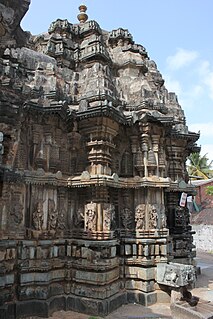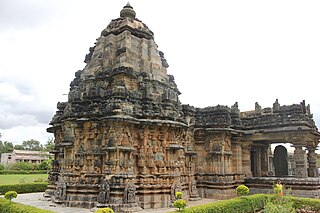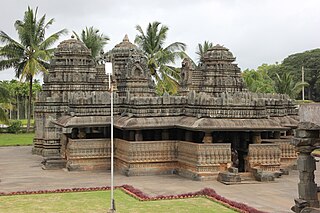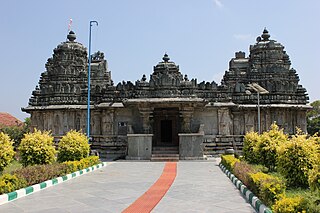
Lakshmi Narasimha Temple, dedicated to an incarnation of the Hindu god Vishnu, was built by the Hoysalas in the early 13th century. It is located in Bhadravati, an industrial town and taluk in the Shimoga District of Karnataka state, India. It is situated at a distance of about 255 km from the state capital Bangalore and at about 20 km from the district headquarters Shimoga. The art historian Adam Hardy categorizes the architectural style as a triple shrine (vimana) construction with two "exceptional" stellate forms, one for the shrine facing west and one for the shrines facing north and south, the basic building material being Soap stone. The temple stands on a jagati and the outer wall exhibits a two tier decorative plan. The monument is protected by the Karnataka state division of Archaeological Survey of India.
Some famous temples built by the Western Chalukyas, referred to as the "Later Chalukya art" that flourished in and around the Tungabhadra River districts of modern Karnataka state, India, are included in the table below.

The Ishvara Temple in Arasikere town of the Hassan district in Karnataka state, India, dates to c. 1220 CE rule of Hoysala Empire. Arasikere is located 140 km north of the historic city of Mysore and 41 km east of Hassan city. The temple, which is dedicated to the Hindu God Shiva, though modest in size and figure sculpture, is considered the most complex one in architecture among surviving Hoysala monuments because of its ground plan: a 16-point star-shaped mantapa (hall), in addition to an asymmetrical star-shaped shrine, whose star points are of three different types.

The Kalleshwara temple is located in the town of Hire Hadagali of the Hoovina Hadagalitaluk in Bellary district of Karnataka state, India.

The Mallikarjuna temple is located in the town of Kuruvatti in the Bellary district of Karnataka state, India. The temple was constructed in the early 12th century rule of the Western Chalukya Empire. The temple is protected as a monument of national importance by the Archaeological Survey of India.

The Kaitabheshvara temple is located in the town of Kubatur, near Anavatti in the Shimoga district of Karnataka state, India. The temple was constructed during the reign of Hoysala King Vinayaditya around 1100 AD. The Hoysala ruling family was during this time a powerful feudatory of the imperial Western Chalukya Empire ruled by King Vikramaditya VI. According to the Archaeological Survey of India, the architectural signature of the temple is mainly "Chalukyan". Art historian Adam Hardy classifies the style involved in the construction of the temple as "Later Chalukya, non mainstream, far end of spectrum". The building material used is soapstone The temple is protected as a monument of national importance by the Archaeological Survey of India.

The Kedareshvara temple is located in the town of Balligavi, near Shikaripura in the Shimoga district of Karnataka state, India. Dotted with centres of learning (agrahara), Balligavi was an important city during the 11th - 12th century Western Chalukya rule. The term Anadi Rajadhani used in medieval inscriptions to describe this town tells a tale of great antiquity. Art historian Adam Hardy classifies the style involved in the construction of the temple as "Later Chalukya, non mainstream, relatively close to mainstream". He dates the temple to late 11th century, with inscriptional evidence of additions made up to 1131, by the Hoysalas during their control over the region. The building material used is soapstone. The Archaeological Survey of India classifies the style of architecture as distinctly Hoysala. The Hoysala ruling family was during this period a powerful feudatory of the imperial Western Chalukya Empire, gaining the trappings of independence only from the period of King Vishnuvardhana. The temple is protected as a monument of national importance by the Archaeological Survey of India.

Kedareshwara Temple is a Hoysala era construction in the historically important town of Halebidu, in the Hassan district of Karnataka state, India. It is located a short distance away from the famous Hoysaleswara Temple. The temple was constructed by Hoysala King Veera Ballala II and his Queen Ketaladevi, and the main deity is Ishwara. The temple is protected as a monument of national importance by the Archaeological Survey of India.

Panchalingeshwara Temple in Govindanahalli, Mandya district, Karnataka state, India, was constructed around 1238 A.D. during the reign of the Hoysala empire King Vira Someshwara. The name "Panchalingeshwara" literally means "five linga". The temple is protected as a monument of national importance by the Archaeological Survey of India. The famous sculptor of Hoysala times, Ruvari Mallitamma, is known to have made contributions to the temple.

The Rameshvara temple at Koodli in the Shimoga district of Karnataka state is a Hoysala construction of the non-ornate variety and is dated to the 12th century. Koodli is a town of great antiquity and is located about 9 km north-east of Shimoga city, the district headquarters. The town gets its name because it is situated at the confluence of the Tunga and Bhadra tributaries that form the Tungabhadra river. According to art historian Adam Hardy, the temple is a single vimana with an open mantapa (hall) built with Soap stone. The temple is protected as a monument of national importance by the Archaeological Survey of India.

The Saumyakeshava temple at Nagamangala was constructed in the 12th century by the rulers of the Hoysala empire. Nagamangala is a town in the Mandya district of Karnataka state, India. It is located 62 km from the historically important town Mysore, on the Srirangapatna-Sira highway. Historically, Nagamangala came into prominence during the rule of Hoysala King Vishnuvardhana when it became an important center of Vaishnava faith and received patronage from one of his queens, Bommaladevi. During the rule of Veera Ballala II, Nagamangala prospered as an agrahara and had the honorific Vira Ballala Chaturvedi Bhattaratnakara. The temple is protected as a monument of national importance by the Archaeological Survey of India.

The Nanesvara Temple, is a mid-11th century Hindu temple in the Later Chalukya style. It stands across the street from the ornate Kasivisvesvara Temple in the famous temple town of Lakkundi in the Gadag district of Karnataka State, India. The temple is protected as a monument of national importance by the Archaeological Survey of India.

The Shankareshvara temple, dedicated to the Hindu god Shiva is located in Turuvekere, a small town in the Tumkur district, Karnataka state, India. Turuvekere, founded as an Agraharam town in the 13th century is located about 77 miles from the state capital Bangalore. The temple was built around 1260 A.D. during the rule of the Hoysala Empire King Narasimha III. This temple is a protected monument under the Karnataka state division of the Archaeological Survey of India.

The Chennakeshava temple, dedicated to the Hindu god Vishnu is located in Turuvekere, a small town in the Tumkur district, Karnataka state, India. Turuvekere, founded as an Agraharam town in the 13th century is located about 77 miles from the state capital Bangalore. The temple was built around 1263 A.D. during the rule of the Hoysala Empire King Narasimha III. This temple is a protected monument under the Karnataka state division of the Archaeological Survey of India.

The Chennakeshava temple, dedicated to the Hindu god Vishnu is located in the village of Hullekere, in the Arasikere Taluk, about 22 km from the commercial town Arasikere. It was built in 1163 A.D. by a minister of Hoysala empire king Narasimha I. The art historian Adam Hardy categorizes the architectural style as a single shrine (vimana) construction with miniature vimanas, the basic building material being Soap stone. The monument is protected by the Karnataka state division of Archaeological Survey of India.

The Lakshminarasimha temple, dedicated to the Hindu god Vishnu is located in the village of Vignasante in the Tumkur district of Karnataka state, India. It was built in 1286 A.D. during the rule of the Hoysala empire king Narasimha III. The art historian Adam Hardy categorizes the architectural style as three shrined temple with closed mantapa, the basic building material being Soap stone. The monument is protected by the Karnataka state division of the Archaeological Survey of India.

Shantinatha Basadi, a Jain temple dedicated to the sixteenth Tirthankar Shantinatha is located in the historically important temple town of Jinanathapura near Shravanabelagola. It is a village in Channarayapatna taluk in the Hassan district of Karnataka state, India.

The Yoga Madhava temple, dedicated to the Hindu god Vishnu is located in Settikere, in the Tumkur district of Karnataka state, India.

The Mallikarjuna Temple at Hirenallur is a Hoysala era construction. Hirenallur is a village, about 12 km from Kadur, Chikkamagaluru district, in the Karnataka state, India. The monument is protected by the Karnataka state division of Archaeological Survey of India. The monument which was in a state of dis-repair was renovated around 2004 by the "Sri Dharmasthala Manjunathaeshwara Dharmothana Trust", with assistance of the Department of Culture, Government of India.

Govindanahalli is a small village in Mandya district of Karnataka state, southern India.

























